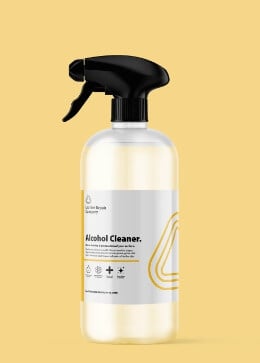Common “Leather Care Remedies” that Actually Ruin Leather (and what to use instead)
Have a problem with your leather items and not sure how to fix it? Getting different pieces of advice everywhere you turn? Here are a handful of so-called “leather care remedies” that will do you more harm than good.
There is a lot of misinformation out there. Keep these tips in mind or what was once a minor problem could become a major one!

Why it’s important to use the right leather care products
Leather goods are fantastically durable and attractive in just about any setting. But, without the right cleaning and maintenance protocols, your pristine leather items can suffer.

The effect of alcohol on a leather couch.
The reason for this is that using harsh chemicals—think anything alcohol-based, or strong industrial solvents—does more than just remove dirt and grime from the surface of the leather. These substances actually strip away the natural oils, causing discoloration or drying the leather out.
And, sadly, once the damage is done, fixing it becomes much more challenging.
Most importantly, avoid alcohol and abrasive solvents for leather products
The best way to remember what you can and can’t use on your leather is to keep this in mind:
The two most commonly used chemicals that will cause severe damage to your leather are rubbing alcohol and acetone.

Avoid any alcohol-based cleaning products for leather goods.
A lot of seemingly more budget-friendly products sold on Amazon and other marketplaces often contain harsh chemicals not ideal for cleaning leather. Stay away from products that contain isopropyl alcohol, ethanol, ethyl alcohol, bleach, and other harsh substances at all costs—regardless of what you read online.
What other leather care remedies should I avoid?
1. Fingernail polish remover – Do not attempt to use fingernail polish remover to get a stain or mark off your leather. Fingernail polish contains acetone, which removes all color from leather, creating a large bleached-looking spot around the area where it is applied.
2. Window cleaner – Many people group Windex and other window cleaners in the “harmless cleaner” category. While these cleaners are often mild, they still contain alcohol that ruins the topcoat on leather furniture.
3. Markers – Using a similar colored marker in an attempt to conceal a problem in your leather is likely to make the problem area worse and even more noticeable. It is darn near impossible to find a marker that will match your leather dye well, and the ink itself can be damaging. Many types of leather have what is called a sauvage, or marbled-looking, finish that you will never be able to recreate with a marker.
4. Shoe polish – Remember this, the leather on your shoes is tanned differently from the leather on your furniture. Furniture leather will not accept or soak up shoe polish in same the way that shoe leather does because it is made differently. Shoe polish will just make a gunky mess on your furniture and on the pants of everyone who sits there.
5. Hair Spray – Some sources swear by hair spray to remove stains and marks on your leather. This is definitely a bad idea. There are a couple of major problems with hair spray. First, most hair spray contains alcohol that damages leather (see #2). Second, hair spray is not very effective for removing marks, and its sticky residue collects more dirt and dust, causing further problems and discoloration in many cases.
6. Disposable cleaning supplies such as disinfectant wipes or pre-wet sponges. The vast majority of these contain alcohol and are a bad idea. We don’t recommend that you use these items, but if you decide to do it, make sure you read the label and are absolutely certain there is no alcohol in the product.
So, what should I use for my leather cleaning needs?
The best substance to use is a dedicated leather cleaner followed by a leather conditioner made specifically for this purpose.
But if you’re in a pinch, there are also leather care alternatives that actually do the trick:
- Mild soap and warm water: Take it back to basics by combining liquid dishwashing soap and warm water, then applying the mixture gently to your leather item with a clean cloth until dirt or grime is removed. Remember to use a non-acidic soap to avoid any complications.
- White Vinegar: Mix equal parts white vinegar and warm water, then apply it to the stained area in a circular motion with a soft cloth. Let the natural antiseptic air dry and you’re good to go.
If you’re hesitant about any of these solutions, be sure to always try them on a small, inconspicuous area before applying any substance to your leather en masse.
For more information, check out our post on cleaning leather.
More questions?
If you have questions about any other remedies, leave them in the comments section and we’ll get you the answers!
Passionate about leather care and restoration?
Earning a great living while protecting the environment might be the right opportunity for you!
Request your free copy of Fibrenew’s Franchise Information Report today for everything you need to know.




